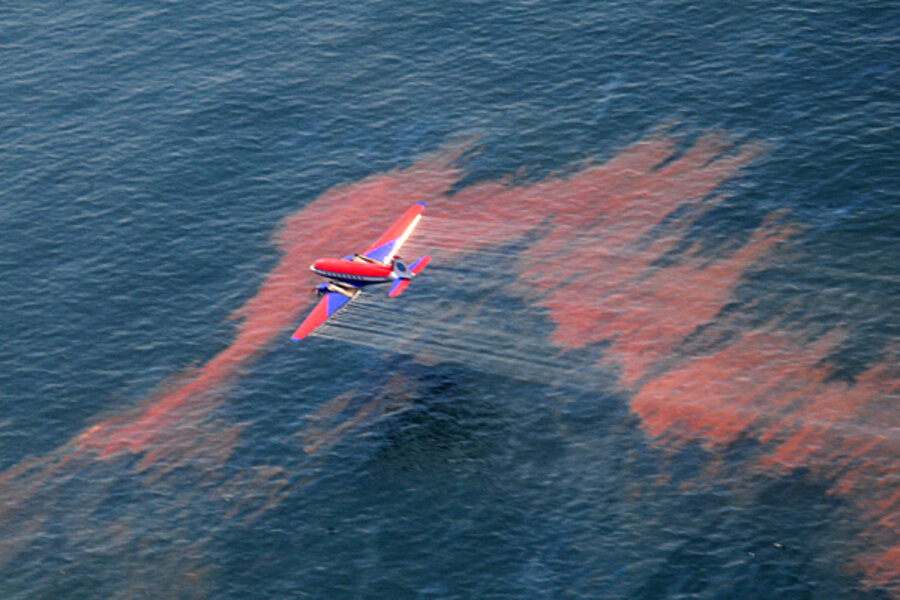EPA scolds BP in Gulf oil spill: dispersant is too toxic, change it
Loading...
The US Environmental Protection Agency reversed course in the Gulf oil spill cleanup effort Thursday, telling BP that had three days to stop using a chemical dispersant that the EPA’s own data suggests is unnecessarily toxic.
As recently as last week, the EPA said it had no power to force BP to use a certain dispersant. All it could do, Administrator Lisa Jackson said, was provide a list of approved dispersants from which BP could choose.
But the EPA essentially overruled itself Thursday by forcing BP’s hand. The company has 24 hours to “identify a less toxic alternative” and 72 hours to begin using it.
IN PICTURES: Louisiana oil spill
The move was prompted by the unprecedented size of the cleanup operation.
So far “dispersants have been used in much greater volume than ever” in US waters, said Jane Lubchenco, administrator for the National Oceanic and Atmospheric Administration (NOAA), Thursday. That is why agencies including her own “became increasingly concerned about the specific dispersant being used,” she added.
Size of spill: BP had it wrong, apparently
The size of the spill was also called into question Thursday, when BP reported that its siphon was now collecting 5,000 barrels of oil a day. BP had previously reported that the well was leaking 5,000 barrels of oil a day, but video of the leak clearly showed significant amounts of oil still escaping into the Gulf of Mexico.
It bolstered comments by independent scientists that far more than 5,000 barrels of oil has been leaking into the Gulf daily.
In a conference call with reporters Thursday, Ms. Lubchenco said pursuing estimates for the leak have so far been secondary to stopping the flow at the source.
“That’s not to say anyone thought the estimates are unimportant,” Lubchenco said. “Everybody thinks it is important to get a good estimation. The response has not been pegged to … a worst case scenario.”
The White House stepped in Thursday to demand that BP provide more specifics about the scope of the spill and its flow rate. Homeland Security Secretary Janet Napolitano and the EPA’s Jackson sent a joint letter Thursday to BP demanding it set up a website in 24 hours that posts all pertinent plans, reports, and videos.
The letter says the company’s efforts to keep the public as well as lawmakers informed of the exact details of the spill “have fallen short in both their scope and effectiveness."
BP's dispersant choice
To deal with the massive spill, BP has applied more than 650,000 gallons of dispersant above and below the water. That volume – and the prospect that much more will be used – led the EPA to demand its less toxic alternative.
The two dispersants used by BP, Corexit EC9500A and Corexit EC9527A, are either comparable or 10 to 20 times more toxic than 12 other dispersants on the EPA’s approved list.
Not much is known about the underwater use of dispersants, especially with the high doses being used in the Gulf. Since Sunday, when the EPA allowed BP to inject the dispersants underwater, about 55,000 gallons have been released below the surface.
Environmentalists consider their use effective for ridding surface waters of oil but say when the toxins are broken down and become embedded on the sea bed they pose a significant threat to marine life.
Rep. Edward Markey (D) of Massachusetts, the chairman of the Energy and Environmental Subcommittee, applauded the EPA’s decision. “The effect of long-term use of dispersants on the marine ecosystem has not been extensively studied, and we need to act with the utmost of caution,” he said in a statement released Thursday.
As BP changes gears in its containment, oil washed up along the beaches of Elmer’s Island, a six-mile wide wildlife refuge off the coast of Louisiana. The island is known for its camping and bird watching opportunities.
The discovery prompted state officials to ban all fishing from Elmer’s Island to Fourchon Beach, a three-mile stretch of water off the state’s western shoreline.
IN PICTURES: Louisiana oil spill
Related:





